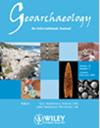Issue Information
IF 1.4
3区 地球科学
0 ARCHAEOLOGY
引用次数: 0
发行信息
本文章由计算机程序翻译,如有差异,请以英文原文为准。
求助全文
约1分钟内获得全文
求助全文
来源期刊

Geoarchaeology-An International Journal
地学-地球科学综合
CiteScore
3.60
自引率
5.90%
发文量
51
审稿时长
>12 weeks
期刊介绍:
Geoarchaeology is an interdisciplinary journal published six times per year (in January, March, May, July, September and November). It presents the results of original research at the methodological and theoretical interface between archaeology and the geosciences and includes within its scope: interdisciplinary work focusing on understanding archaeological sites, their environmental context, and particularly site formation processes and how the analysis of sedimentary records can enhance our understanding of human activity in Quaternary environments. Manuscripts should examine the interrelationship between archaeology and the various disciplines within Quaternary science and the Earth Sciences more generally, including, for example: geology, geography, geomorphology, pedology, climatology, oceanography, geochemistry, geochronology, and geophysics. We also welcome papers that deal with the biological record of past human activity through the analysis of faunal and botanical remains and palaeoecological reconstructions that shed light on past human-environment interactions. The journal also welcomes manuscripts concerning the examination and geological context of human fossil remains as well as papers that employ analytical techniques to advance understanding of the composition and origin or material culture such as, for example, ceramics, metals, lithics, building stones, plasters, and cements. Such composition and provenance studies should be strongly grounded in their geological context through, for example, the systematic analysis of potential source materials.
 求助内容:
求助内容: 应助结果提醒方式:
应助结果提醒方式:


